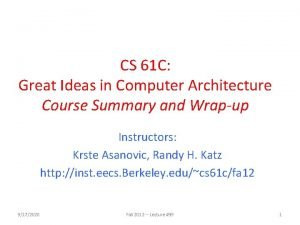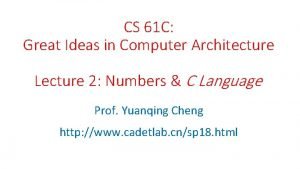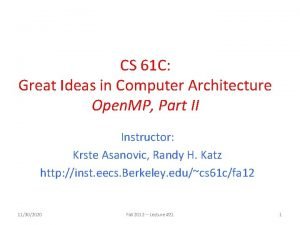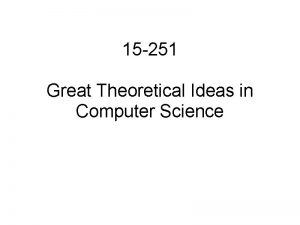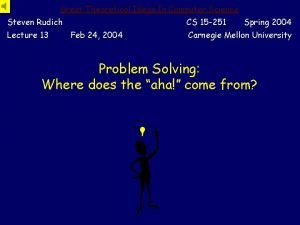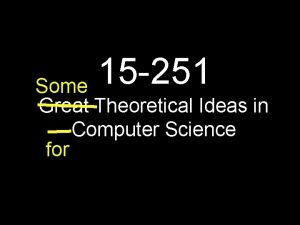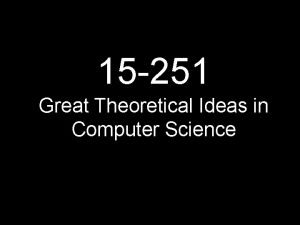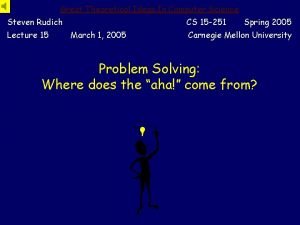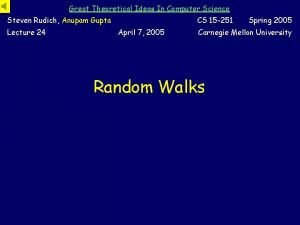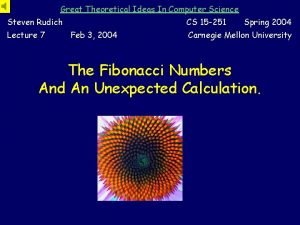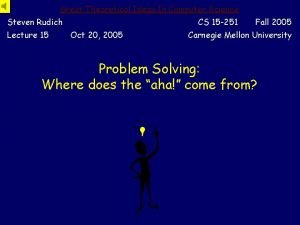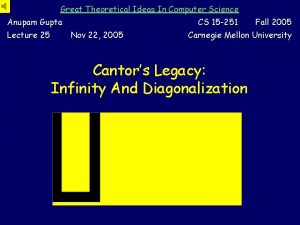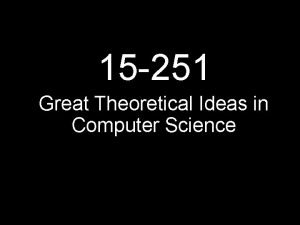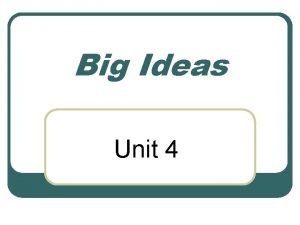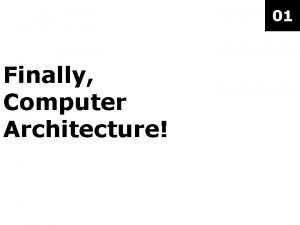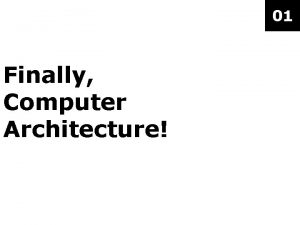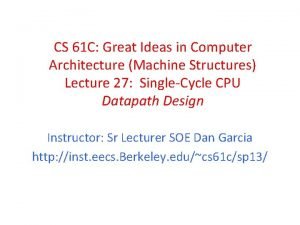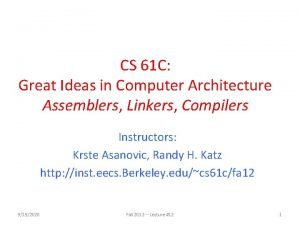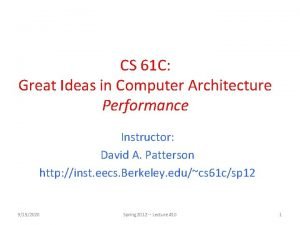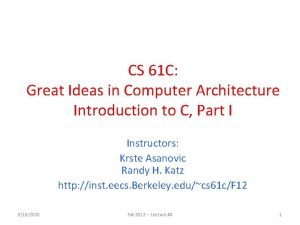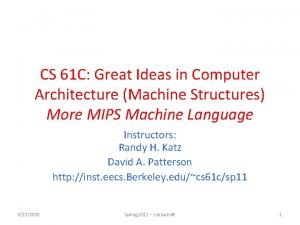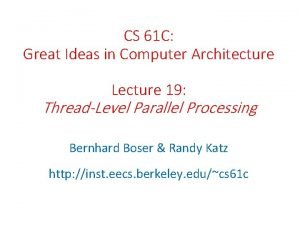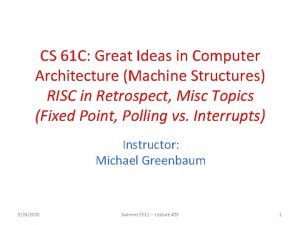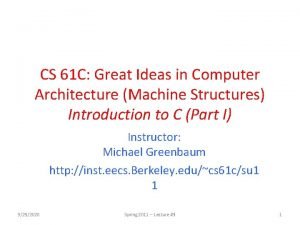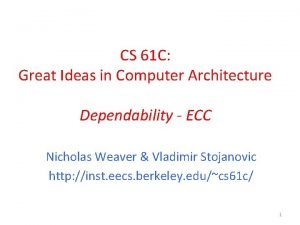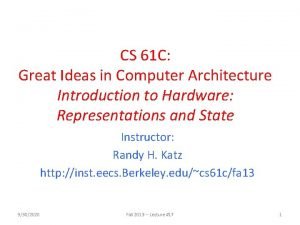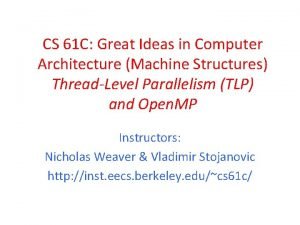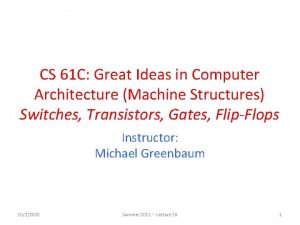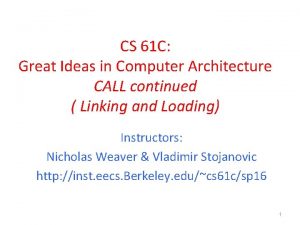CS 61 C Great Ideas in Computer Architecture














































- Slides: 46

CS 61 C: Great Ideas in Computer Architecture Performance and Floating-Point Arithmetic Instructors: Krste Asanović & Randy H. Katz http: //inst. eecs. berkeley. edu/~cs 61 c/fa 17 10/26/2020 Fall 2017 -- Lecture #17 1

Outline • Defining Performance • Floating-Point Standard • And in Conclusion … 10/26/2020 2

What is Performance? • Latency (or response time or execution time) – Time to complete one task • Bandwidth (or throughput) – Tasks completed per unit time 10/26/2020 3

Cloud Performance: Why Application Latency Matters • Key figure of merit: application responsiveness – Longer the delay, the fewer the user clicks, the less the user happiness, and the lower the revenue per user 10/26/2020 4

CPU Performance Factors • A program executes instructions • CPU Time/Program = Clock Cycles/Program x Clock Cycle Time = Instructions/Program x Average Clock Cycles/Instruction x Clock Cycle Time • 1 st term called Instruction Count • 2 nd term abbreviated CPI for average Clock Cycles Per Instruction • 3 rd term is 1 / Clock rate 10/26/2020 5

Restating Performance Equation • Time = Seconds Program Instructions Clock cycles Seconds = Program × Instruction× Clock Cycle CPU Iron Law! 10/26/2020 6

What Affects Each Component? Instruction Count, CPI, Clock Rate Hardware or software component? Affects What? Algorithm Programming Language Compiler Instruction Set Architecture 10/26/2020 Instruction Count, CPI Instruction Count, Clock Rate, CPI 7

Peer Instruction Computer Clock frequency Clock cycles per instruction #instructions per program RED 1. 0 GHz 2 1000 GREEN 2. 0 GHz 5 800 ORANGE 0. 5 GHz 1. 25 400 YELLOW 5. 0 GHz 10 2000 • Which computer has the highest performance for a given program? 10/26/2020 8

Peer Instruction System A B Rate (Task 1) 10 20 Rate (Task 2) 20 10 Which system is faster? RED: System A GREEN: System B ORANGE: Same performance YELLOW: YELLOW Unanswerable question! 10/26/2020 9

Workload and Benchmark • Workload: Set of programs run on a computer – Actual collection of applications run or made from real programs to approximate such a mix – Specifies both programs and relative frequencies • Benchmark: Program selected for use in comparing computer performance – Benchmarks form a workload – Usually standardized so that many use them 10/26/2020 10

SPEC (System Performance Evaluation Cooperative) • Computer Vendor cooperative for benchmarks, started in 1989 • SPECCPU 2006 – 12 Integer Programs – 17 Floating-Point Programs • Often turn into number where bigger is faster • SPECratio: reference execution time on old reference computer divided by execution time on new computer, reported as speedup • (SPEC 2017 just released) 10/26/2020 11

SPECINT 2006 on AMD Barcelona Description Interpreted string processing Block-sorting compression GNU C compiler Combinatorial optimization Go game Search gene sequence Chess game Quantum computer simulation Video compression Discrete event simulation library Games/path finding XML parsing Instruction Count (B) CPI Clock cycle time (ps) Execution Time (s) Reference Time (s) SPECratio 2, 118 0. 75 400 637 9, 770 15. 3 2, 389 1, 050 0. 85 1. 72 400 817 724 9, 650 8, 050 11. 8 11. 1 336 1, 658 2, 783 2, 176 10. 0 1. 09 0. 80 0. 96 400 400 1, 345 721 890 837 9, 120 10, 490 9, 330 12, 100 6. 8 14. 6 10. 5 14. 5 1, 623 3, 102 1. 61 0. 80 400 1, 047 993 20, 720 22, 130 19. 8 22. 3 587 1, 082 1, 058 2. 94 1. 79 2. 70 400 400 690 773 1, 143 6, 250 7, 020 6, 900 9. 1 12 6. 0

Summarizing SPEC Performance • Varies from 6 x to 22 x faster than reference computer • Geometric mean of ratios: N-th root of product of N ratios – Geometric Mean gives same relative answer no matter what computer is used as reference • Geometric Mean for Barcelona is 11. 7 10/26/2020 13

Administrivia • Midterm 2 in one week! – Guerrilla Session tonight 7 -9 pm in Cory 293 – ONE double sided cheat sheet – Stay tuned for room assignments – Review session: Saturday 10 -12 pm in Hearst Annex A 1 • Homework 4 released! – Caches and Floating Point – Due after the midterm – Still good cache practice! • Proj 2 -Part 2 released – Due after the midterm, but good to do before! 10/26/2020 14

Outline • Defining Performance • Floating-Point Standard • And in Conclusion … 10/26/2020 Fall 2016 – Lecture #17 15

Quick Number Review • Computers deal with numbers • What can we represent in N bits? – 2 N things, and no more! They could be… • Unsigned integers: 0 to 2 N - 1 (for N=32, 2 N – 1 = 4, 294, 967, 295) • Signed Integers (Two’s Complement) -2(N-1) to 2(N-1) - 1 (for N=32, 2(N-1) = 2, 147, 483, 648) 10/26/2020 16

Other Numbers 1. Very large numbers? (seconds/millennium) � 31, 556, 926, 00010 (3. 155692610 x 1010) 2. Very small numbers? (Bohr radius) � 0. 0000052917710 m (5. 2917710 x 10 -11) 3. Numbers with both integer & fractional parts? � 1. 5 • First consider #3 • …our solution will also help with #1 and #2 10/26/2020 17

Goals for Floating Point • Standard arithmetic for reals for all computers – Like two’s complement • Keep as much precision as possible in formats • Help programmer with errors in real arithmetic – +∞, -∞, Not-A-Number (Na. N), exponent overflow, exponent underflow • Keep encoding that is somewhat compatible with two’s complement – E. g. , 0 in Fl. Pt. is 0 in two’s complement – Make it possible to sort without needing to do floating-point comparison 10/26/2020 18

Representation of Fractions • “Binary Point” like decimal point signifies boundary between integer and fractional parts: Example 6 -bit representation: 10. 1010 two xx. yyyy 21 20 2 -1 2 -2 2 -3 2 -4 = 1 x 21 + 1 x 2 -3 = 2. 625 ten If we assume “fixed binary point”, range of 6 -bit representations with this format: 0 to 3. 9375 (almost 4) 10/26/2020 19

Fractional Powers of 2 i 10/26/2020 0 1 2 3 4 5 6 7 8 9 10 11 12 13 14 15 2 -i 1. 0 1 0. 5 1/2 0. 25 1/4 0. 125 1/8 0. 0625 1/16 0. 03125 1/32 0. 015625 0. 0078125 0. 00390625 0. 001953125 0. 0009765625 0. 00048828125 0. 000244140625 0. 0001220703125 0. 00006103515625 0. 000030517578125 20

Representation of Fractions with Fixed Pt. What about addition and multiplication? Addition is straightforward: 01. 100 1. 5 ten + 00. 100 0. 5 ten 10. 000 2. 0 ten 01. 100 1. 5 ten 00. 100 0. 5 ten Multiplication a bit more complex: 00 000 00 Where’s the answer, 0. 11? (e. g. , 0. 5 + 0. 25; 0110 0 Need to remember where point is!) 00000 10/26/2020 0000110000 21

Representation of Fractions Our examples used a “fixed” binary point. What we really want is to “float” the binary point to make most effecitve use of limited bits example: put 0. 1640625 ten into binary. Represent with 5 -bits choosing where to put the binary point. … 000000. 001010100000… Store these bits and keep track of the binary point 2 places to the left of the MSB Any other solution would lose accuracy! • With floating-point representation, each numeral carries an exponent field recording the whereabouts of its binary point • Binary point can be outside the stored bits, so very large and small numbers can be represented 10/26/2020 22

Scientific Notation (in Decimal) mantissa exponent 6. 02 ten x 1023 decimal point radix (base) • Normalized form: no leadings 0 s (exactly one digit to left of decimal point) • Alternatives to representing 1/1, 000, 000 – Normalized: 1. 0 x 10 -9 – Not normalized: 0. 1 x 10 -8, 10. 0 x 10 -10 10/26/2020 23

Scientific Notation (in Binary) mantissa exponent 1. 01 two x 2 -1 “binary point” radix (base) • Computer arithmetic that supports it is called floating point, because it represents numbers where the binary point is not fixed, as it is for integers – Declare such variable in C as float • double for double precision 10/26/2020 24

Floating-Point Representation (1/4) • 32 -bit word has 232 patterns, so must be approximation of real numbers ≥ 1. 0, < 2 • IEEE 754 Floating-Point Standard: – 1 bit for sign (s) of floating point number – 8 bits for exponent (E) – 23 bits for fraction (F) (get 1 extra bit of precision if leading 1 is implicit) (-1)s x (1 + F) x 2 E • Can represent from 2. 0 x 10 -38 to 2. 0 x 1038 10/26/2020 25

Floating-Point Representation (2/4) • Normal format: +1. xxx…xtwo*2 yyy…ytwo • Multiple of Word Size (32 bits) 31 30 23 22 S Exponent 1 bit 8 bits • • Significand 23 bits S represents Sign Exponent represents y’s Significand represents x’s Represent numbers as small as 2. 0 ten x 10 -38 to as large as 2. 0 ten x 1038 10/26/2020 0 26

Floating-Point Representation (3/4) • What if result too large? (> 2. 0 x 1038 , < -2. 0 x 1038 ) – Overflow! Exponent larger than represented in 8 -bit Exponent field • What if result too small? (>0 & < 2. 0 x 10 -38 , <0 & > -2. 0 x 10 -38 ) – Underflow! Negative exponent larger than represented in 8 -bit Exponent field overflow underflow overflow 2 x 1038 -1 -2 x 10 -38 0 2 x 10 -38 1 • What would help reduce chances of overflow and/or underflow? 10/26/2020 27

Floating-Point Representation (4/4) • What about bigger or smaller numbers? • IEEE 754 Floating-Point Standard: Double Precision (64 bits) – 1 bit for sign (s) of floating-point number – 11 bits for exponent (E) – 52 bits for fraction (F) (get 1 extra bit of precision if leading 1 is implicit) (-1)s x (1 + F) x 2 E • Can represent from 2. 0 x 10 -308 to 2. 0 x 10308 • 32 -bit format called Single Precision 10/26/2020 28

Which is Less? (i. e. , closer to -∞) • 0 vs. 1 x 10 -127 ? • 1 x 10 -126 vs. 1 x 10 -127 ? • -1 x 10 -127 vs. 0 ? • -1 x 10 -126 vs. -1 x 10 -127 ? 10/26/2020 29

Floating Point: Representing Very Small Numbers • Zero: Bit pattern of all 0 s is encoding for 0. 000 But 0 in exponent should mean most negative exponent (want 0 to be next to smallest real) Can’t use two’s complement (1000 0000 two) • Bias notation: subtract bias from exponent – Single precision uses bias of 127; DP uses 1023 • 0 uses 0000 two => 0 -127 = -127; ∞, Na. N uses 1111 two => 255 -127 = +128 10/26/2020 – Smallest SP real can represent: 1. 00… 00 x 2 -126 – Largest SP real can represent: 1. 11… 11 x 2+127 30

IEEE 754 Floating-Point Standard (1/3) Single Precision (Double Precision similar): 31 30 23 22 S Exponent Significand 0 1 bit 8 bits 23 bits • Sign bit: 1 means negative 0 means positive • Significand in sign-magnitude format (not 2’s complement) – To pack more bits, leading 1 implicit for normalized numbers – 1 + 23 bits single, 1 + 52 bits double – always true: 0 < Significand < 1 (for normalized numbers) • Note: 0 has no leading 1, so reserve exponent value 0 just for number 0 10/26/2020 31

IEEE 754 Floating-Point Standard (2/3) • IEEE 754 uses “biased exponent” representation – Designers wanted FP numbers to be used even if no FP hardware; e. g. , sort records with FP numbers using integer compares – Wanted bigger (integer) exponent field to represent bigger numbers – 2’s complement poses a problem (because negative numbers look bigger) • Use just magnitude and offset by half the range 10/26/2020 32

IEEE 754 Floating-Point Standard (3/3) • Called Biased Notation, where bias is number subtracted to get final number − IEEE 754 uses bias of 127 for single precision − Subtract 127 from Exponent field to get actual exponent value • Summary (single precision): 31 30 S Exponent 1 bit 8 bits 23 22 Significand 23 bits 0 • (-1)S x (1 + Significand) x 2(Exponent-127) • Double precision identical, except with exponent bias of 1023 (half, quad similar) 10/26/2020 33

Bias Notation (+127) How it is interpreted How it is encoded ∞, Na. N Getting closer to zero Zero 10/26/2020 34

Peer Instruction • Guess this Floating Point number: 1 1000 0000 0000 • RED: -1 x 2128 • GREEN: +1 x 2 -128 • ORANGE: -1 x 21 • YELLOW: -1. 5 x 21 10/26/2020 35

More Floating Point • What about 0? – Bit pattern all 0 s means 0, so no implicit leading 1 • What if divide 1 by 0? – Can get infinity symbols +∞, -∞ – Sign bit 0 or 1, largest exponent (all 1 s), 0 in fraction • What if do something stupid? (∞ – ∞, 0 ÷ 0) – Can get special symbols Na. N for “Not-a-Number” – Sign bit 0 or 1, largest exponent (all 1 s), not zero in fraction • What if result is too big? (2 x 10308 x 2 x 102) – Get overflow in exponent, alert programmer! • What if result is too small? (2 x 10 -308 ÷ 2 x 102) – Get underflow in exponent, alert programmer! 10/26/2020 36

Representation for ± ∞ • In FP, divide by 0 should produce ± ∞, not overflow • Why? – OK to do further computations with ∞ E. g. , X/0 > Y may be a valid comparison • IEEE 754 represents ± ∞ – Most positive exponent reserved for ∞ – Significand all zeroes 10/26/2020 37

Representation for 0 • Represent 0? – Exponent all zeroes – Significand all zeroes – What about sign? Both cases valid +0: 0 000000000000000 -0: 1 0000000000000000 10/26/2020 38

Special Numbers • What have we defined so far? (Single Precision) Exponent 0 0 1 -254 255 10/26/2020 Significand 0 nonzero anything 0 nonzero Object 0 ? ? ? +/- fl. pt. # +/- ∞ ? ? ? 39

Representation for Not-a-Number • What do I get if I calculate sqrt(-4. 0)or 0/0? – If ∞ not an error, these shouldn’t be either – Called Not a Number (Na. N) – Exponent = 255, Significand nonzero • Why is this useful? – Hope Na. Ns help with debugging? – They contaminate: op(Na. N, X) = Na. N – Can use the significand to identify which! (e. g. , quiet Na. Ns and signaling Na. Ns) 10/26/2020 40

Representation for Denorms (1/2) • Problem: There’s a gap among representable FP numbers around 0 – Smallest representable positive number: a = 1. 0… 2 * 2 -126 = 2 -126 – Second smallest representable positive number: b = 1. 000…… 1 2 * 2 -126 Normalization = (1 + 0. 00… 12) * 2 -126 and implicit 1 = (1 + 2 -23) * 2 -126 is to blame! = 2 -126 + 2 -149 Gaps! a - 0 = 2 -126 b - a = 2 -149 b - 10/26/2020 0 a + 41

Representation for Denorms (2/2) • Solution: − We still haven’t used Exponent = 0, Significand nonzero − DEnormalized number: no (implied) leading 1, implicit exponent = -126 − Smallest representable positive number: a = 2 -149 (i. e. , 2 -126 x 2 -23) � Second-smallest representable positive number: b = 2 -148 (i. e. , 2 -126 x 2 -22) 10/26/2020 0 + 42

Special Numbers Summary • Reserve exponents, significands: Exponent 0 0 1 -254 255 10/26/2020 Significand 0 nonzero anything 0 Nonzero Object 0 Denorm +/- fl. pt. number +/- ∞ Na. N 43

Saving Bits • Many applications in machine learning, graphics, signal processing can make do with lower precision • IEEE “half-precision” or “FP 16” uses 16 bits of storage – 1 sign bit – 5 exponent bits (exponent bias of 15) – 10 significand bits • Microsoft “Brain. Wave” FPGA neural net computer uses proprietary 8 -bit and 9 -bit floating-point formats 44

Outline • Defining Performance • Floating Point Standard • And in Conclusion … 10/26/2020 45

And In Conclusion, … • Time (seconds/program) is measure of performance Instructions Clock cycles Seconds × Instruction × Clock Cycle = Program • Floating-point representations hold approximations of real numbers in a finite number of bits IEEE 754 Floating-Point Standard is most widely accepted attempt to standardize interpretation of such numbers (Every desktop or server computer sold since ~1997 follows these conventions) - Single Precision: 31 30 23 22 0 - S Exponent 1 bit 8 bits 10/26/2020 Significand 23 bits 46
 List the eight great ideas invented by computer architects
List the eight great ideas invented by computer architects Cs 61
Cs 61 8 great ideas in computer architecture
8 great ideas in computer architecture 8 great ideas in computer architecture
8 great ideas in computer architecture Great theoretical ideas in computer science
Great theoretical ideas in computer science Great theoretical ideas in computer science
Great theoretical ideas in computer science Great theoretical ideas in computer science
Great theoretical ideas in computer science Great ideas in computer science
Great ideas in computer science Cmu 15251
Cmu 15251 Great theoretical ideas in computer science
Great theoretical ideas in computer science Great theoretical ideas in computer science
Great theoretical ideas in computer science Great theoretical ideas in computer science
Great theoretical ideas in computer science Vocabularize
Vocabularize Great theoretical ideas in computer science
Great theoretical ideas in computer science Great theoretical ideas in computer science
Great theoretical ideas in computer science Three bus architecture
Three bus architecture Computer architecture vs organization
Computer architecture vs organization Flowchart for memory reference instructions
Flowchart for memory reference instructions Ideas have consequences bad ideas have victims
Ideas have consequences bad ideas have victims Que son las ideas complementarias
Que son las ideas complementarias China big idea
China big idea Turning great strategy into great performance
Turning great strategy into great performance Great faces great places
Great faces great places Leadership comes with great responsibility
Leadership comes with great responsibility Great white shark vs great hammerhead
Great white shark vs great hammerhead Does alexander the great deserve his title
Does alexander the great deserve his title Enlightened despot
Enlightened despot With great expectations comes great responsibility
With great expectations comes great responsibility A great deal vs a great many
A great deal vs a great many With great power comes great responsibility
With great power comes great responsibility Did alexander the great deserve to be called great
Did alexander the great deserve to be called great No shadow of turning
No shadow of turning What is architecture business cycle?
What is architecture business cycle? Data centered architecture
Data centered architecture Integral architecture example
Integral architecture example Product architecture examples
Product architecture examples Computer organization and architecture 10th solution
Computer organization and architecture 10th solution Fast desktop for architecture software
Fast desktop for architecture software Computer architecture lab experiments
Computer architecture lab experiments Introduction to computer organization and architecture
Introduction to computer organization and architecture Timing and control in computer architecture
Timing and control in computer architecture Computer architecture: concepts and evolution
Computer architecture: concepts and evolution I/o modules in computer architecture
I/o modules in computer architecture Fp adder
Fp adder Wipro
Wipro Static interconnection network in computer architecture
Static interconnection network in computer architecture Smt in computer architecture
Smt in computer architecture

